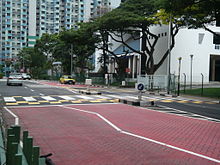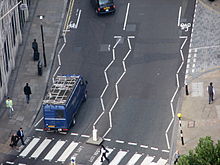- Zebra crossing
-
A zebra crossing is a type of pedestrian crossing used in many places around the world. Its distinguishing feature is alternating dark and light stripes on the road surface, from which it derives its name. A zebra crossing typically gives extra rights of way to pedestrians.
The use of zebra crossings is somewhat contested in traffic engineering circles. Because they give priority to pedestrians, without slowing down vehicles, they may encourage unsafe behaviour. Research undertaken in New Zealand summarises that a zebra crossing without other safety features on average increases pedestrian crashes by 28% compared to a location without crossings. However, if combined with (placed on top of) a speed table, zebra crossings were found to reduce pedestrian crashes by 80%.[1]
Contents
Characteristics
The crossing is characterised by longitudinal stripes on the road, parallel to the flow of the traffic, alternately a light colour and a dark one. The similarity of these markings to those of a zebra give the crossing's name. The light colour is usually white and the dark colour may be painted – in which case black is typical – or left unpainted if the road surface itself is dark. The stripes are typically 40 to 60 centimetres (16 inches to 2 feet) wide. If there are no additional traffic lights, pedestrians always have right of way on a zebra crossing. In countries such as the United Kingdom, zebra markings are used only where pedestrians have permanent right of way. In other countries they are also used on pedestrian crossings controlled by traffic signals, and pedestrians have priority only when the lights show green to pedestrians.[citation needed]
History
After isolated experiments, the zebra crossing was first used at 1000 sites in the UK in 1949 in its original form of alternating strips of blue and yellow, and a 1951 measure introduced them into law. In 1971, the Green Cross Code was introduced to teach children safer crossing habits, replacing the earlier "kerb drill".
In the United Kingdom the crossing is marked with Belisha beacons, flashing amber globes on black and white posts on each side of the road, named after Leslie Hore-Belisha, the Minister of Transport, who introduced them in 1934. The crossings were originally marked by beacons and parallel rows of studs, and the stripes were added for visibility some 15 years later.
Regional variations
See also: Pedestrian crossingIn the United Kingdom, lollipop men or women (crossing guards) frequently attend zebra crossings in school hours.
In the Netherlands, Germany, Scandinavia and most other European countries, pedestrians have right of way if they are still on the curb but about to enter the zebra crossing.
In North America, zebra crossings are almost exclusively called crosswalks, and in most North American cities, crossing in an area of the street other than the crosswalk is called jaywalking and, though rarely enforced, is technically a misdemeanor offense.
In New Zealand, motorists are required to give way to pedestrians. If crossing the road within 20m of a zebra crossing pedestrians must use the crossing.
Tiger crossing
A tiger crossing is a variation used in the United Kingdom and Hong Kong, a former British colony. It is painted yellow and black. In the UK, it allows cyclists to cross in a central area of the road without dismounting, and motorists must give way to both cyclists and pedestrians. Aylesbury in Buckinghamshire experimented with tiger crossings in 2006 and 2007, but replaced them with toucan crossings.[2][3] Switzerland also uses yellow stripes for pedestrian crossings. But unlike mentioned above, cyclists are required to dismount to cross the road.
In popular culture
 A zebra crossing in Abbey Road, London. This same crossing was featured on the cover of the Beatles' album Abbey Road
A zebra crossing in Abbey Road, London. This same crossing was featured on the cover of the Beatles' album Abbey Road
A zebra crossing appears on the cover of The Beatles' Abbey Road album. It made it a tourist attraction, and it has been incorporated into the Abbey Road Studios logo. Since the Abbey Road photo was taken, zigzag lines at the kerb and in the centre of the road have been added to all zebra crossings to indicate the no-stopping zones on either side. The band Shriekback's album Sacred City contains an entire song, "Beatles Zebra Crossing?", about the Abbey Road zebra crossing and its status as a tourist attraction.
There is also a tongue-in-cheek reference to zebra crossings in the science-fiction comedy The Hitchhiker's Guide to the Galaxy by English author Douglas Adams, in reference to Man using the improbable creature called the Babel fish as proof to the non-existence of God... the novel says, "Man then goes on to prove that black is white and gets himself killed at the next zebra crossing."
References
- ^ Pedestrian planning and design guide. Land Transport New Zealand / New Zealand Transport Agency. 2007. ISBN 978-0-478-30945-4.
- ^ Cambridge Cycling Campaign (2007). "The Crossings Menagerie" (http). camcycle.org.uk. http://www.camcycle.org.uk/newsletters/71/article12.html. Retrieved October 11, 2007.
- ^ Buckinghamshire County Council (2006). "Aylesbury hub Cabinet report" (http). honestjohn.co.uk. http://www.buckscc.gov.uk/bcc/content/index.jsp?contentid=1597570376. Retrieved October 11, 2007.[dead link]
- Notes
- History of Road Safety, Gerald Cummins
- The History of British Roadsigns, Department for Transport, 2nd Edition, 1999
External links
- Zebra crossing in Canadian Centre for Architecture exhibition
- Traffic signals and pedestrian crossings
- UK road markings and road signs
Panda crossing · Pedestrian scramble · Pegasus crossing · Pelican crossing · Puffin crossing · Tiger crossing · Toucan crossing · Zebra crossingCategories:- Pedestrian crossings
- Cycling safety
Wikimedia Foundation. 2010.




